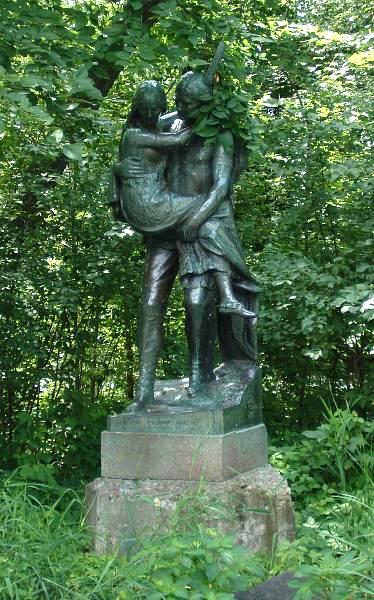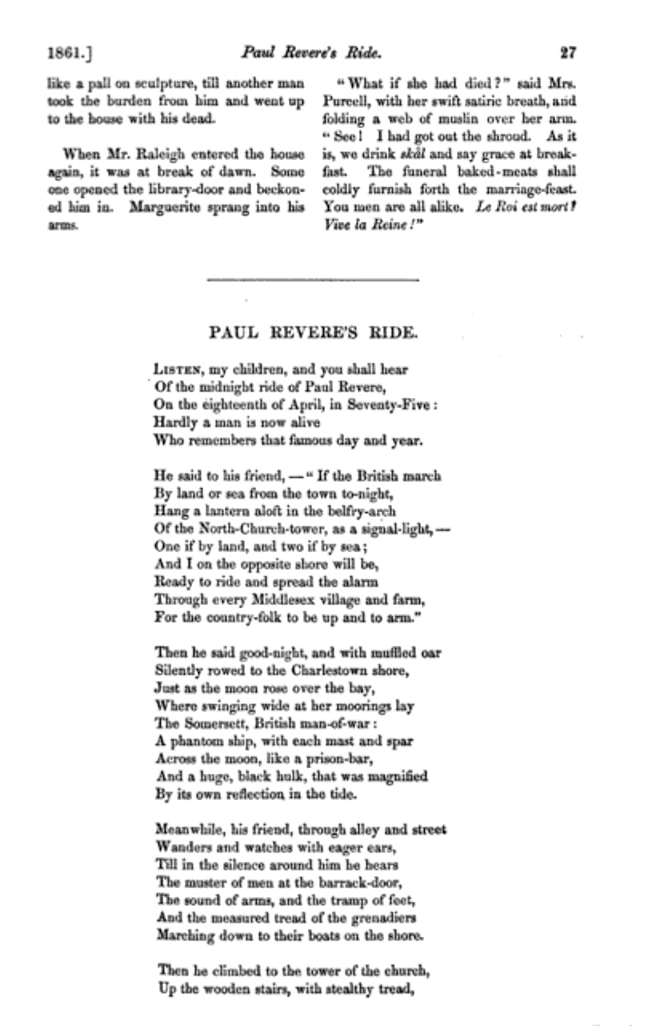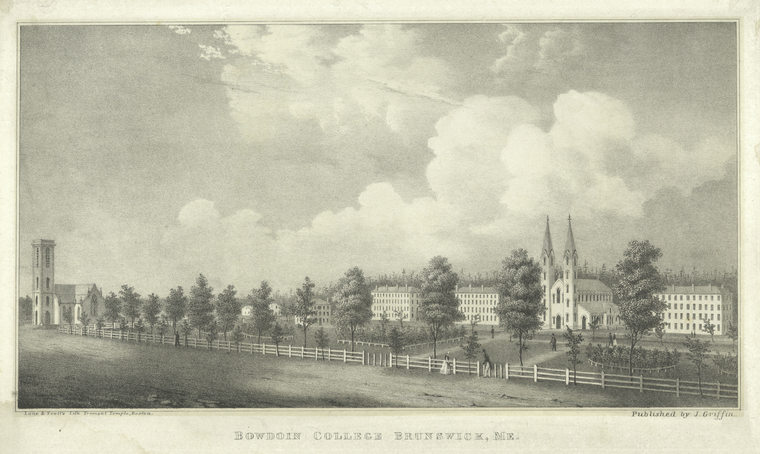|
Longfellow
Henry Wadsworth Longfellow (February 27, 1807 – March 24, 1882) was an American poet and educator. His original works include "Paul Revere's Ride", ''The Song of Hiawatha'', and ''Evangeline''. He was the first American to completely translate Dante Alighieri's ''Divine Comedy'' and was one of the fireside poets from New England. Longfellow was born in Portland, Maine, which was then still part of Massachusetts. He graduated from Bowdoin College and became a professor there and, later, at Harvard College after studying in Europe. His first major poetry collections were ''Voices of the Night'' (1839) and ''Ballads and Other Poems'' (1841). He retired from teaching in 1854 to focus on his writing, and he lived the remainder of his life in the Revolutionary War headquarters of George Washington in Cambridge, Massachusetts. His first wife, Mary Potter, died in 1835 after a miscarriage. His second wife, Frances Appleton, died in 1861 after sustaining burns when her dress caught ... [...More Info...] [...Related Items...] OR: [Wikipedia] [Google] [Baidu] |
Alice Mary Longfellow
Alice Mary Longfellow (September 22, 1850 – December 7, 1928) was a philanthropist, preservationist, and the eldest surviving daughter of the American poet Henry Wadsworth Longfellow. She is best known as "grave Alice" from her father's poem " The Children's Hour". Longfellow was born in Cambridge, Massachusetts, and attended classes at Radcliffe College during the 1880s and 1890s, studying at Newnham College in Cambridge, England, from 1883 to 1884.Cambridge, Massachusetts. Longfellow House – Washington's Headquarters National Historic Site, Alice Mary Longfellow Papers Collection, Box 19, Folder 8. Journal for academic year at Newnham 1883–4. She traveled frequently throughout her life, spending the majority of her time abroad in France and Italy. Most notably, she met with Benito Mussolini in 1927. Alice Longfellow remained unmarried throughout her life. She died in Cambridge in 1928 in the same house where she was born. Longfellow worked to preserve her father's home in ... [...More Info...] [...Related Items...] OR: [Wikipedia] [Google] [Baidu] |
Longfellow House–Washington's Headquarters National Historic Site
The Longfellow House–Washington's Headquarters National Historic Site (also known as the Vassall-Craigie-Longfellow House and, until December 2010, Longfellow National Historic Site) is a historic site located at 105 Brattle Street in Cambridge, Massachusetts. It was the home of noted American poet Henry Wadsworth Longfellow for almost 50 years, and it had previously served as the headquarters of General George Washington (1775–76). The house was built in 1759 for Jamaican planter John Vassall, Jr., who fled the Cambridge area at the beginning of the American Revolutionary War because of his loyalty to the king of England. George Washington occupied it as his headquarters beginning on July 16, 1775, and it served as his base of operations during the Siege of Boston until he moved out on April 4, 1776. Andrew Craigie, Washington's Apothecary General, was the next person to own the home for a significant period of time. He purchased the house in 1791 and instigated its only majo ... [...More Info...] [...Related Items...] OR: [Wikipedia] [Google] [Baidu] |
The Song Of Hiawatha
''The Song of Hiawatha'' is an 1855 epic poem in trochaic tetrameter by Henry Wadsworth Longfellow which features Native American characters. The epic relates the fictional adventures of an Ojibwe warrior named Hiawatha and the tragedy of his love for Minnehaha, a Dakota woman. Events in the story are set in the Pictured Rocks area of Michigan on the south shore of Lake Superior. Longfellow's poem is based on oral traditions surrounding the figure of Manabozho, but it also contains his own innovations. Longfellow drew some of his material from his friendship with Ojibwe Chief '' Kahge-ga-gah-bowh'', who would visit at Longfellow's home. He also had frequent encounters with Black Hawk and other Sauk people on Boston Common, and he drew from ''Algic Researches'' (1839) and other writings by Henry Rowe Schoolcraft, an ethnographer and United States Indian agent, and from ''Heckewelder's Narratives''. In sentiment, scope, overall conception, and many particulars, Longfellow insi ... [...More Info...] [...Related Items...] OR: [Wikipedia] [Google] [Baidu] |
Evangeline
''Evangeline, A Tale of Acadie'' is an epic poem by the American poet Henry Wadsworth Longfellow, written in English and published in 1847. The poem follows an Acadian girl named Evangeline and her search for her lost love Gabriel, set during the time of the Expulsion of the Acadians. The idea for the poem came from Longfellow's friend Nathaniel Hawthorne. Longfellow used dactylic hexameter, imitating Greek and Latin classics. Though the choice was criticized, it became Longfellow's most famous work in his lifetime and remains one of his most popular and enduring works. The poem had a powerful effect in defining both Acadian history and identity in the nineteenth and twentieth centuries. It represents lost loved ones and heartbreak; but also keeping hope as she did in the poem. More recent scholarship has revealed the historical errors in the poem and the complexity of the Expulsion and those involved, which the poem ignores. Plot ''Evangeline'' describes the betrothal of a ... [...More Info...] [...Related Items...] OR: [Wikipedia] [Google] [Baidu] |
Wadsworth-Longfellow House
The Wadsworth-Longfellow House is a historic house and museum in Portland, Maine, United States. It is located at 489 Congress Street and is operated by the Maine Historical Society. It was designated a National Historic Landmark in 1962, and administratively added to the National Register of Historic Places in 1966. The house is open daily to public from May through October (half days on Sundays). An admission fee is charged. History The house has both historical and literary importance, as it is both the oldest standing structure on the Portland peninsula and the childhood home of American poet Henry Wadsworth Longfellow (1807–1882). American Revolutionary War General Peleg Wadsworth built the house in 1785–1786, the first wholly brick dwelling in Portland. Wadsworth raised ten children in the two-story structure with a pitched roof before retiring to the family farm in Hiram, Maine, in 1807. His daughter Zilpah and her husband Stephen Longfellow IV were married ... [...More Info...] [...Related Items...] OR: [Wikipedia] [Google] [Baidu] |
Ernest Wadsworth Longfellow
Ernest Wadsworth Longfellow (1845–1921) was an American artist in Boston, Massachusetts, and New York. He was the son of Henry Wadsworth Longfellow. Biography Ernest Longfellow was born in Cambridge, Massachusetts, and raised at Craigie House. He was the second of six children, including his younger sister Alice Mary Longfellow. Educated at Harvard College, he passed the winter of 1865 and '66 in Paris in work and study, and the summers of 1876 and '77 in Villiers-le-Bel under Couture.Clement and Hutton. 1879 He married Harriet "Hattie" Spelman in 1868. An 1874 newspaper gossiped about him: "Ernest Longfellow, the son of the poet, is described as a slender, delicate young man, an artist of talent, great at ten-pins, and tip-top at gunning." "His professional life has been spent in Boston, with frequent visits to Europe." In the 1870s he kept a studio on West Street. He exhibited at the National Academy of Design in 1871 and 1875; the Williams & Everett gallery in Boston i ... [...More Info...] [...Related Items...] OR: [Wikipedia] [Google] [Baidu] |
Paul Revere's Ride
"Paul Revere's Ride" is an 1860 poem by American poet Henry Wadsworth Longfellow that commemorates the actions of American patriot Paul Revere on April 18, 1775, although with significant inaccuracies. It was first published in the January 1861 issue of ''The Atlantic Monthly''. It was later retitled "The Landlord's Tale" in Longfellow's 1863 collection ''Tales of a Wayside Inn''. Overview The poem is spoken by the landlord of the Wayside Inn and tells a partly fictionalized story of Paul Revere. In the poem, Revere tells a friend to prepare signal lanterns in the Old North Church (North End, Boston) to inform him whether the British will attack by land or sea. He would await the signal across the river in Charlestown and be ready to spread the alarm throughout Middlesex County, Massachusetts. The unnamed friend climbs up the steeple and soon sets up two signal lanterns, informing Revere that the British are coming by sea. Revere rides his horse through Medford, Lexington, an ... [...More Info...] [...Related Items...] OR: [Wikipedia] [Google] [Baidu] |
Fireside Poets
The fireside poets – also known as the schoolroom or household poets – were a group of 19th-century American poets associated with New England. These poets were very popular among readers and critics both in the United States and overseas. Their domestic themes and messages of morality presented in conventional poetic forms deeply shaped their era until their decline in popularity at the beginning of the 20th century. Overview The group is typically thought to include Henry Wadsworth Longfellow, William Cullen Bryant, John Greenleaf Whittier, James Russell Lowell, and Oliver Wendell Holmes Sr., who were the first American poets whose popularity rivaled that of British poets, both at home and abroad. Ralph Waldo Emerson is occasionally included in the group as well. The name "fireside poets" is derived from that popularity; their writing was a source of entertainment for families gathered around the fire at home. The name was further inspired by Longfellow's 1850 poetry collect ... [...More Info...] [...Related Items...] OR: [Wikipedia] [Google] [Baidu] |
Alexander Wadsworth Longfellow Jr
Alexander Wadsworth Longfellow Jr. (August 18, 1854, Portland, Maine – February 16, 1934, Portland) was an American architect and nephew of poet Henry Wadsworth Longfellow. Biography Alexander Wadsworth Longfellow Jr. was the son of Alexander Wadsworth Longfellow Sr. (1814–1901), a U.S. Coast Survey topographer, and the former Elizabeth Clapp Porter. After graduating from Harvard University in 1876, he studied architecture at the Massachusetts Institute of Technology and the École des Beaux-Arts in Paris, then worked as senior draftsman in Henry Hobson Richardson's office. Career After Richardson's death in 1886, Longfellow teamed up with Frank Ellis Alden (1859–1908) and Alfred Branch Harlow (1857–1927) to found the firm of Longfellow, Alden & Harlow, with offices in Boston and Pittsburgh. The firm designed the Carnegie Library of Pittsburgh and the City Hall in Cambridge, Massachusetts. They also designed the Arnold Arboretum headquarters, the Hunnewell Building ... [...More Info...] [...Related Items...] OR: [Wikipedia] [Google] [Baidu] |
Stephen Longfellow
Stephen Longfellow (March 23, 1776 – August 2, 1849) was a U.S. Representative from Maine. Biography Born in Gorham in the Province of Massachusetts Bay (in what is now Maine) to Stephen Longfellow and Patience Young Longfellow, Longfellow attended Phillips Academy, Andover, MA, and then from Harvard University in 1798. He studied law and was admitted to the bar in 1801 and commenced practice in Portland, Maine. He married Zilpah Wadsworth in 1804 and, with her, had eight children, including the poets Henry Wadsworth Longfellow and Samuel Longfellow. He served as a member of the general court of Massachusetts in 1814 and 1815. He belonged to the Federalist Party and was a delegate to the Hartford Convention in 1814 and 1815. He also served as a Federalist presidential elector in 1816. Longfellow was elected as an Adams-Clay Federalist to the Eighteenth Congress (March 4, 1823 – March 3, 1825). He was not a candidate for renomination in 1824 and resumed his law practice for ... [...More Info...] [...Related Items...] OR: [Wikipedia] [Google] [Baidu] |
Peleg Wadsworth
Peleg Wadsworth (May 6, 1748 – November 12, 1829) was an American Patriot officer during the American Revolutionary War and a Congressman from Massachusetts representing the District of Maine. He was also grandfather of noted American poet Henry Wadsworth Longfellow. Wadsworth was born in Duxbury in the Province of Massachusetts Bay, to Peleg and Susanna (Sampson) Wadsworth. He graduated from Harvard College with an A.B. (1769) and an A.M. (1772), and taught school for several years in Plymouth, Massachusetts, with his former classmate Alexander Scammel. There he met Elizabeth Bartlett (1753 to 1825), whom he married in 1772. American Revolutionary War The Wadsworths lived in Kingston, until 1775, when Wadsworth recruited a company of minutemen, of which he was chosen captain. His company mustered in response to the alarms generated by the Battle of Lexington and Concord on April 19, 1775. The Plymouth County battalion, commanded by Col. Theophilus Cotton marched to ... [...More Info...] [...Related Items...] OR: [Wikipedia] [Google] [Baidu] |
Bowdoin College
Bowdoin College ( ) is a private liberal arts college in Brunswick, Maine. When Bowdoin was chartered in 1794, Maine was still a part of the Commonwealth of Massachusetts. The college offers 34 majors and 36 minors, as well as several joint engineering programs with Columbia, Caltech, Dartmouth College, and the University of Maine. The college was a founding member of its athletic conference, the New England Small College Athletic Conference, and the Colby-Bates-Bowdoin Consortium, an athletic conference and inter-library exchange with Bates College and Colby College. Bowdoin has over 30 varsity teams, and the school mascot was selected as a polar bear in 1913 to honor Robert Peary, a Bowdoin alumnus who led the first successful expedition to the North Pole. Between the years 1821 and 1921, Bowdoin operated a medical school called the Medical School of Maine. The main Bowdoin campus is located near Casco Bay and the Androscoggin River. In addition to its Brunswick campus, ... [...More Info...] [...Related Items...] OR: [Wikipedia] [Google] [Baidu] |






_(14595373847).jpg)
